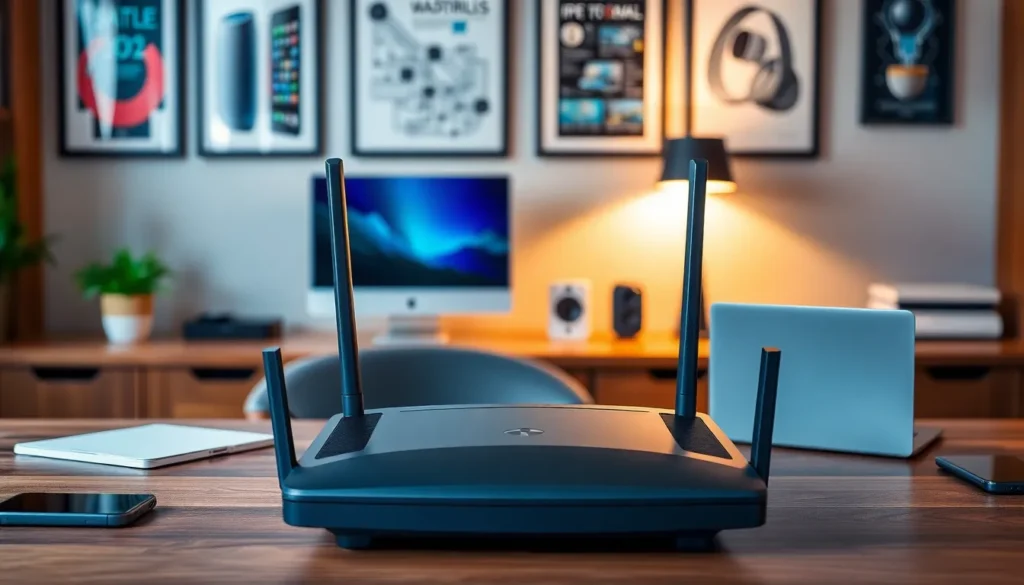In today’s digital age, having a reliable internet connection is essential. But with a multitude of routers available, ensuring compatibility with devices can be a daunting task. Router compatibility affects everything from speed to network security, making it crucial for users to understand how to choose the right equipment.
Many factors influence router compatibility, including standards like Wi-Fi 5 and Wi-Fi 6, as well as the devices connecting to the network. Whether it’s a smart home gadget or a gaming console, knowing which routers work best with specific devices can enhance performance and user experience. This guide will explore the key aspects of router compatibility, helping users make informed decisions for their home or office networks.
Understanding Router Compatibility
Router compatibility determines how well a router integrates with various devices and networks. Knowing this concept helps users select the right equipment for optimal performance.
Definition of Router Compatibility
Router compatibility refers to the ability of a router to function with different devices and network standards. It involves assessing supported Wi-Fi protocols, such as 802.11ac or 802.11ax, hardware interfaces, and firmware compatibility. A compatible router effectively communicates with devices, ensuring seamless internet access and network stability.
Importance of Router Compatibility
Router compatibility significantly influences network performance and user experience. When choosing a router, factors like Wi-Fi standard compatibility directly affect connection speed and range. Ensuring compatibility with existing devices prevents issues like connectivity drops or limited functionality. Additionally, using a compatible router enhances network security by supporting updated encryption methods, helping to protect sensitive information.
Factors Affecting Router Compatibility

Several factors determine router compatibility, impacting speed, connectivity, and user experience. Understanding these elements ensures users select an optimal router for their needs.
Internet Service Provider Requirements
Internet Service Providers (ISPs) impose specific requirements for routers. Routers must support the ISP’s network technology, such as DSL, cable, or fiber. Users need to check compatibility with their ISP’s service plans, including speed tiers and modem specifications. Some ISPs offer approved router lists; selecting a router from these lists ensures proper functionality. Additionally, certain ISPs require routers to be registered on their networks, which can enhance performance and service reliability.
Device Compatibility
Device compatibility plays a significant role in router performance. Routers must support various devices’ operating systems, such as Windows, macOS, iOS, and Android. Compatibility with Wi-Fi standards, including 802.11b/g/n/ac/ax, is essential, as older devices may only support earlier standards, limiting performance. Users must consider the number of devices on their network; higher router capacity accommodates multiple connections without sacrificing speed. Evaluating supported features, such as MU-MIMO or beamforming, helps users ensure their router meets the demands of modern devices and applications.
Common Compatibility Issues
Router compatibility issues can arise due to various factors, impacting performance and connectivity. Users often face challenges related to wireless standards and firmware limitations.
Wireless Standards
Wireless standards play a crucial role in router compatibility. Most routers support multiple Wi-Fi protocols, including 802.11n, 802.11ac, and 802.11ax. Devices older than 802.11n may not connect to newer routers and experience slower speeds. Additionally, features like dual-band (2.4 GHz and 5 GHz) can affect connectivity, as some devices may not support the 5 GHz band. Users must verify their devices’ compatibility with the router’s wireless standards to ensure optimal performance and reliable connections.
Firmware Limitations
Firmware limitations contribute significantly to compatibility issues. Routers require regular firmware updates to address bugs and improve performance. An outdated firmware version may result in a failure to connect with new devices or utilize advanced features. Users should periodically check for updates from the manufacturer to enhance router functionality and security. Ensuring that firmware is current involves visiting the manufacturer’s support page or using the router’s web interface to access update options.
Testing Router Compatibility
Testing router compatibility ensures optimal performance and seamless connectivity with existing devices and network standards. Proper testing helps identify any potential issues before installing or updating network equipment.
Steps to Test Compatibility
- Identify Device Specifications: Check the specifications of all devices that will connect to the router. Look for supported Wi-Fi standards, frequency bands, and operating systems.
- Review Router Specifications: Verify the router’s specifications against device requirements. Ensure that the router supports the same Wi-Fi protocols and features expected by connected devices.
- Check ISP Compatibility: Confirm that the router is compatible with the selected Internet Service Provider (ISP). Review the ISP’s requirements for cable, DSL, or fiber connections.
- Connect Devices: Temporarily connect devices to the router using both wired and wireless connections. Test browsing speeds, download speeds, and overall performance.
- Test Range and Coverage: Assess the router’s Wi-Fi coverage throughout the intended usage area. Check for dead spots or weak signals that may impact connectivity.
- Perform a Firmware Update: Update the router’s firmware to the latest version to enhance compatibility with newer devices and features. Test connectivity again after updates.
Tools for Compatibility Testing
- Wi-Fi Analyzer Apps: Use Wi-Fi analyzer applications like NetSpot or WiFi Analyzer to evaluate signal strength, coverage, and interference levels in the environment.
- ISP Testing Tools: Utilize ISP-provided testing tools or services to ensure the router meets network speed and compatibility requirements.
- Device Simulation Software: Implement device simulation software that mimics various devices to assess compatibility without physical connection.
- Performance Benchmarking Tools: Employ performance testing tools such as iPerf or Speedtest to measure speed and performance under different configurations.
- Router Configuration Interfaces: Access the router’s configuration interface to check device connections, bandwidth allocation, and compatibility settings.
Router compatibility is essential for achieving a reliable and efficient network. Users who prioritize compatibility can enhance their internet experience while minimizing connectivity issues. By understanding the factors that influence compatibility and regularly updating firmware, they can ensure their network remains secure and performs optimally.
Selecting the right router involves careful consideration of device specifications and ISP requirements. With the right tools and knowledge, anyone can create a robust network that meets their needs. A compatible router not only supports current devices but also prepares the network for future advancements. Embracing this understanding leads to a seamless digital experience.





